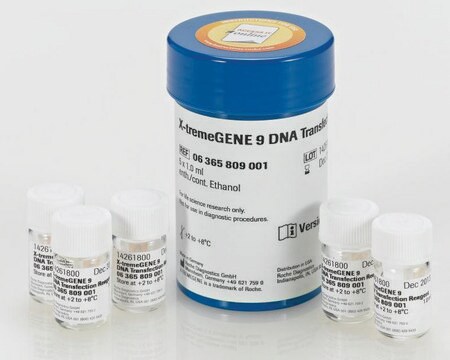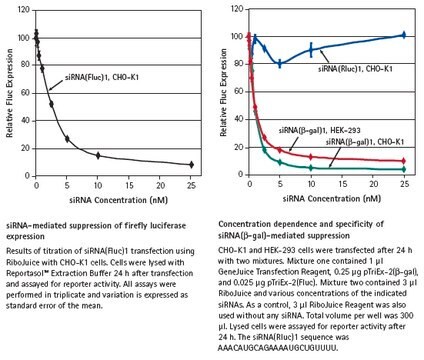L3287
Escort™ IV Transfection Reagent
Lipid reagent for transient and stable transfection of mammalian and insect cells.
Synonym(s):
Gene delivery
About This Item
Recommended Products
grade
for molecular biology
Quality Level
form
liquid (aqueous solution)
usage
1 mL sufficient for 160-500 transfections
concentration
1 mg/mL
technique(s)
transfection: suitable
storage temp.
2-8°C
Related Categories
General description
Application
Features and Benefits
- Suitable for stable and transient transfection
- Optimized for a wide variety of cell lines
- Low toxicity
- Compatible with both serum and serum-free transfection protocols
- Ideal for Sf9, Sf21 and S2 insect cells
Components
1 mg/mL total lipid in water
Note the identity of the lipids used in Escort™ IV is confidential.
Caution
Principle
Legal Information
related product
Storage Class Code
10 - Combustible liquids
WGK
WGK 3
Flash Point(F)
Not applicable
Flash Point(C)
Not applicable
Personal Protective Equipment
Certificates of Analysis (COA)
Search for Certificates of Analysis (COA) by entering the products Lot/Batch Number. Lot and Batch Numbers can be found on a product’s label following the words ‘Lot’ or ‘Batch’.
Already Own This Product?
Find documentation for the products that you have recently purchased in the Document Library.
Customers Also Viewed
Articles
Transfection is the introduction of DNA, RNA, or proteins into eukaryotic cells and is used in research to study and modulate gene expression. Thus, transfection techniques and protocols serve as an analytical tool that facilitates the characterization of genetic functions, protein synthesis, cell growth and development.
This brief webinar provides an overview of what transfection is and the methods that are used to introduce DNA or RNA into eukaryotic cells.
Protocols
Expert guidance on the best way to optimize your transfection experiments. Optimized protocols result in highest efficiency transfections.
Product manual provides detailed protocol for easy DNA transfection.
The product bulletin providin detailed use protocol for easy DNA transfection.
Our Universal Transfection Reagent is a unique formulation of a proprietary polymer blend used for transient and stable transfection of nucleic acids into various eukaryotic cell lines and hard-to-transfect primary cells. This is a fast and easy protocol is compatible with serum, serum-free medium and antibiotics.
Related Content
Browse our convenient transfection reagent selection guide to match the best reagent for your specific cell line and application needs.
Our team of scientists has experience in all areas of research including Life Science, Material Science, Chemical Synthesis, Chromatography, Analytical and many others.
Contact Technical Service











